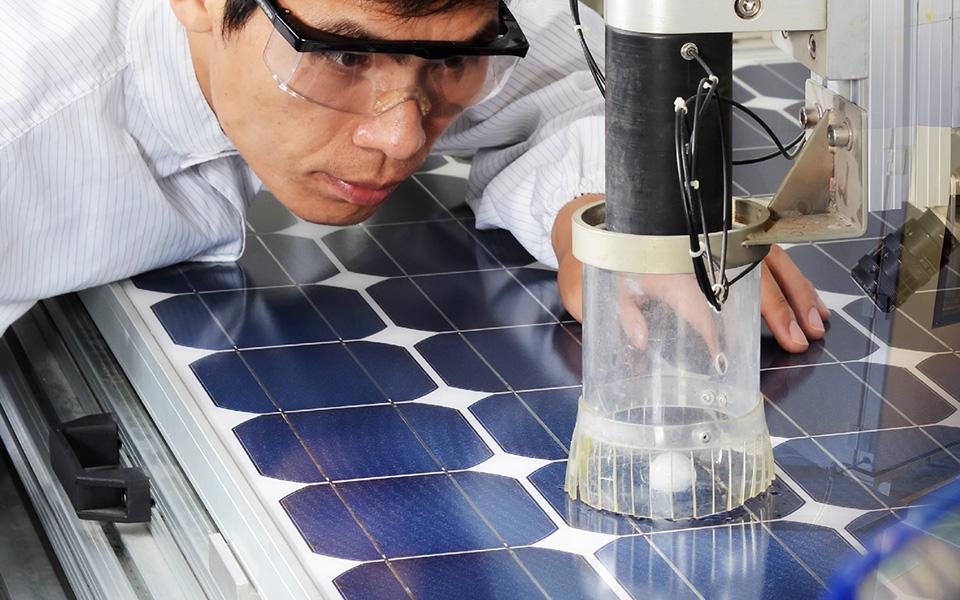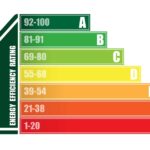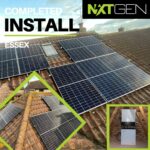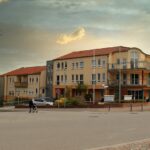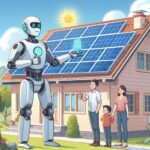☀️ Solar PV cells are usually square-shaped and measure 6 inches by 6 inches (150mm x 150mm).
☀️ There are different configurations of solar cells that make up a solar panel, such as 60-cell, 72-cell, and 96-cell.
☀️ The most common solar panel sizes for residential installations are between 250W and 400W.
The Solar Cell Size Chart below shows the different types of solar photovoltaic (PV) cells that are available on the UK market today. Solar PV cells are devices that convert sunlight into electricity. They are made from silicon (Si), which is a semiconductor material that can absorb light and generate electric current.
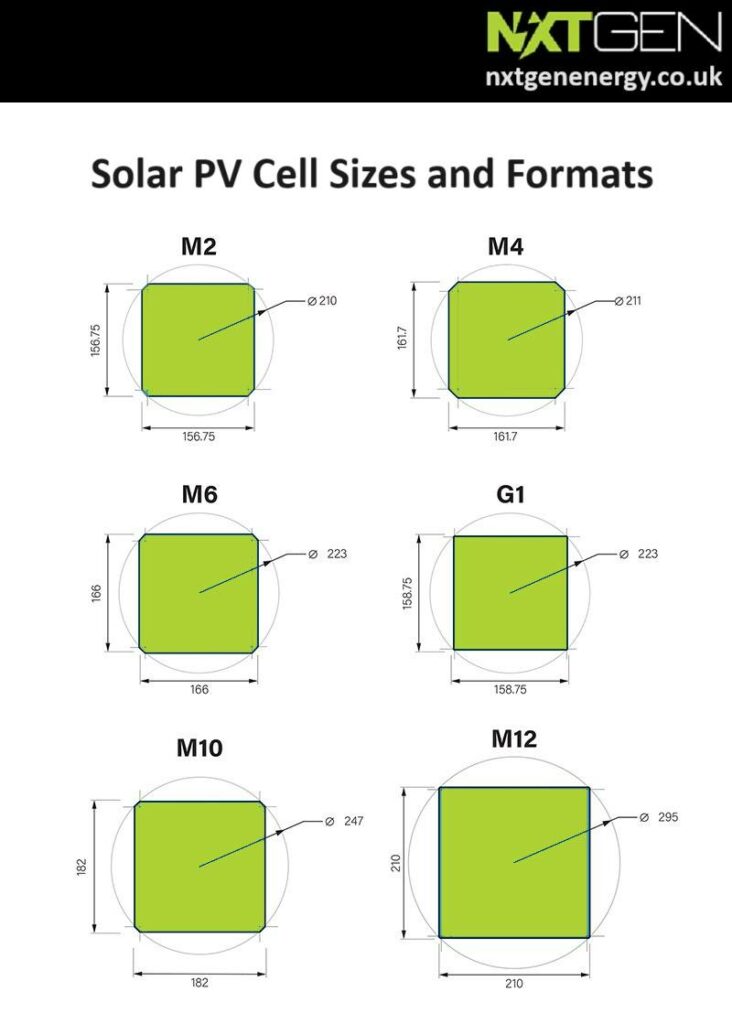
Monocrystalline and Polycrystalline Cells
There are two main categories of solar PV cells: monocrystalline and polycrystalline. Monocrystalline cells are made from a single crystal of silicon, while polycrystalline cells are made from multiple crystals of silicon. Monocrystalline cells have higher efficiency and durability than polycrystalline cells, but they are also more expensive and difficult to produce.
Solar PV Cell Shapes
Monocrystalline cells are produced by cutting thin slices or wafers from a cylindrical ingot of silicon using a laser. The shape of the ingot determines the shape of the cell. If the cell is cut as a perfect circle, it will have the least amount of silicon waste, but it will also leave gaps between the cells when they are arranged in to a solar panel. These gaps reduce the power output of the solar panel, because they do not capture any sunlight.
To increase the power output of the solar panel, solar PV manufacturers try to fill the gaps between the cells by cutting them into different shapes. One common shape is a square with rounded corners, which is called an M2 cell. This shape has a size of 156.75 mm x 156.75 mm (6.17 in x 6.17 in) and has been widely used in the industry for a long time.
Larger Solar PV Cell Sizes
However, as silicon prices have fallen, manufacturers have found it more profitable to cut the cells into larger and more square shapes, which can cover more area in a panel and generate more electricity. This has led to the emergence of various new cell formats, such as M4, M6, G1, M10, and M12. Each format has a different size and edge length, ranging from 161.7 mm (6.37 in) to 210 mm (8.27 in).
Solar PV manufacturers have officially started efforts to establish a new ‘M10’ (182mm x 182mm (7.2 in x 7.2 in) p-type monocrystalline) large-area wafer size standard to reduce manufacturing costs throughout the related solar industry supply chain as the number of large-area wafer sizes have emerged in the last few years.
No Standards for Solar PV Cell Sizes
The problem with having different cell formats is that they also result in different panel sizes. This means that the industry has lost the standardization and compatibility that it had with the M2 cell size format. This can ultimately affect the installation, transportation, and maintenance of solar panels in the future. Therefore, some experts argue that the solar PV industry should agree on a common solar PV cell size and format to avoid confusion and inefficiency.
Conclusion
You now know the different types of solar PV cells and how their shapes and sizes affect the power output and efficiency of solar panels. But the big problem comes from losing standardization and compatibility in the industry due to the different cell formats, and the solar industry should agree on a common PV cell size and format to avoid confusion and inefficiency.
Feeling motivated and ready to switch to solar? Want to learn more? Your best option is to talk to one of our friendly solar energy experts on 01268 928 690 or click on the ‘Enquire Now’ button below and we will help you find the right fit for your home and budget.
Frequently Asked Questions About Solar PV Cell Sizes
A wafer with a length of 166 mm and a maximum diagonal length of 223 mm — with cut corners — is the M6 size. The M2 size, which was the most popular before, had a length of 156.75 mm and a diagonal length of 210 mm.
M6 wafers are compatible with the standard 60- and 72-cell panel frames, but M10 and M12 wafers are larger and require bigger modules that are more suitable for utility-scale solar projects.
The average wattage of domestic solar panels ranges from 250 to 400. Domestic solar panels are usually 1.7 metres in length, 1 metre in width and 3-5cm in thickness. The weight of domestic solar panels is typically between 18kg and 20kg.
To estimate the size of the solar PV system, you need to divide the total amount of electricity that the system needs to produce by the number of hours that the sun is at its peak. This will give you the approximate size of the solar PV array in kilowatt-hours (kWh). Then, divide this number by the efficiency factor of the solar panels, which tells you how much electricity they can produce per unit of area. This will give you the power output of the solar panels in kilowatts (kW).
There are two common types of standard solar panels: 60-cell and 72-cell. A single solar cell has a square shape of 6” x 6”. A 60-cell panel has a 6×10 grid arrangement. A 72-cell panel has a 6×12 grid layout, making it about a foot longer.
The additional photovoltaic cells in 72-cell panels do not always mean higher wattages and power output than 60-cell panels. The power output of a panel is not directly related to the number of cells it has.
Latest Solar Technology Posts
- Why Leisure Centres Should Invest in Solar PanelsIn recent years, the concept of sustainability has become increasingly vital in various industries, including leisure centres. As the global focus shifts towards environmental conservation and renewable energy sources, leisure centres are recognizing the importance of investing in sustainable practices to reduce their operating costs and their carbon footprint. One such sustainable solution gaining traction… Read more: Why Leisure Centres Should Invest in Solar Panels
- School Funding – Solar for SchoolsSolar energy is revolutionizing the way educational institutions approach sustainability and energy consumption. As schools seek innovative solutions to reduce costs, educate students about renewable energy, and minimize their environmental impact, the adoption of solar power has emerged as a compelling choice. Solar For Schools, a leading initiative in the field, empowers educational institutions to… Read more: School Funding – Solar for Schools
- Homes with solar panels can sell for more than those withoutHarnessing the power of the sun to generate clean, renewable energy is not only a sustainable choice for homeowners but also a lucrative investment in the UK property market. Homes equipped with solar panels are increasingly commanding higher prices and attracting more buyers than their non-solar counterparts. In this blog post, we’ll delve into the… Read more: Homes with solar panels can sell for more than those without
- Solar Panels and EPC RatingsSolar panels have become increasingly popular as a sustainable energy solution, offering numerous benefits for both residential and commercial properties. In parallel, Energy Performance Certificate (EPC) ratings serve as indicators of a building’s energy efficiency. Understanding how solar panels can impact EPC ratings is crucial for maximizing energy savings and environmental benefits. This blog post… Read more: Solar Panels and EPC Ratings
- Is it worth buying solar panels in Basildon, Essex?☀️ Over 10,000 homes in Basildon have a solar panel system installed. ☀️ You’ll normally break even on solar panels in less than 10 years. ☀️ A 3.5kW solar panel system will cost about £7,000 on average. Solar panels are becoming more affordable and more common in the UK, with over 1.3 million households already… Read more: Is it worth buying solar panels in Basildon, Essex?
- Wiltshire’s Good Energy Partners with bigHead to Achieve 50% Solar Energy GoalWiltshire-based Good Energy has played a crucial role in helping Dorset manufacturing firm bigHead transition to utilizing solar power for 50% of its energy needs. Thanks to the collaboration between the two companies, bigHead has successfully installed 130 solar panels on the roof of its Verwood factory, resulting in significant cost savings of over £4,000… Read more: Wiltshire’s Good Energy Partners with bigHead to Achieve 50% Solar Energy Goal
- Unveiling the Perfect Fit: How Many Solar Panels Can Your Roof Handle?Harnessing the power of the sun is an attractive proposition for many UK homeowners. But before diving headfirst into solar energy, a crucial question arises: how many solar panels can fit on your roof? The answer, unfortunately, isn’t a simple one. It’s a captivating interplay between several factors, each one requiring careful consideration. Understanding Your… Read more: Unveiling the Perfect Fit: How Many Solar Panels Can Your Roof Handle?
- Powering Care with Sunshine: How Solar Panels Benefit Nursing HomesNursing homes are the backbone of our communities, providing essential care for our elderly population. But keeping these facilities running smoothly requires a significant amount of energy – lighting, heating, cooling and medical equipment all contribute to a hefty energy bill. This is where commercial solar panels come in, offering a win-win solution for both… Read more: Powering Care with Sunshine: How Solar Panels Benefit Nursing Homes
- Who are NXTGEN Energy Ltd?NXTGEN Energy Ltd are a solar energy company based in Rayleigh, Essex, UK. They specialize in the installation of solar panels, battery storage systems, and electric vehicle chargers for homes and businesses across the UK. They are MCS certified, which means they meet the Microgeneration Certification Scheme’s standards for quality and safety. This makes them… Read more: Who are NXTGEN Energy Ltd?
- Why UK Homeowners with Solar Panels Need Bird Proofing (Beyond the Basics)Imagine waking up to the quiet hum of your solar panels, generating clean energy to power your home. It’s a beautiful image, symbolizing lower electricity bills and sustainability. But what if a gang of birds decided the solar panels on your roof were the perfect spot for their new condo complex? Unfortunately, this idyllic scene… Read more: Why UK Homeowners with Solar Panels Need Bird Proofing (Beyond the Basics)
- Solar Panel FinancingAt NXTGEN, we are committed to delivering excellent service and we understand that many customers may prefer the option of paying for their solar panels with finance. So, we’ve partnered with established credit brokers, Ideal4Finance, to enable customers to spread the cost of purchase with manageable monthly payments. We can offer 3 Flexible Finance Options… Read more: Solar Panel Financing
- How AI could supercharge your solar panelsImagine stepping outside on a crisp January morning, a mug of steaming tea warming your hands. You glance at your rooftop, not with dread at energy bills, but with a mischievous grin. Why? Because the sun, that cheeky orb in the sky, is being squeezed for every juicy watt it holds thanks to your AI-powered… Read more: How AI could supercharge your solar panels

